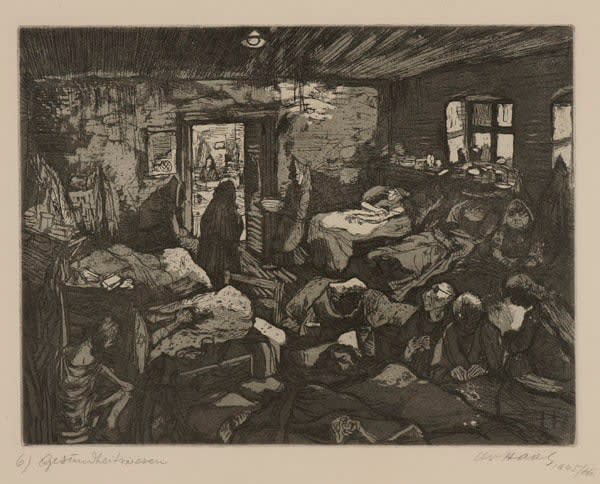Leo Haas 1901-1983
Public Health
drypoint and aquatint on paper
26.8 x 33.8
and dated (lower right): 'Leo Haas 1945/66'
1988-23vi
@Leo Haas estate
Photo: Bridgeman images
In September 1942, Leo Haas was deported to the Terezin (Theresienstadt) ghetto, north of Prague. As an artist, Haas was assigned to the Technical Department to illustrate propaganda material, which...
In September 1942, Leo Haas was deported to the Terezin (Theresienstadt) ghetto, north of Prague. As an artist, Haas was assigned to the Technical Department to illustrate propaganda material, which enabled him to secretly make a series of pictures showing what life in Theresienstadt was really like. He risked his life making these works, hiding the prints in walls and with the other inhabitants of Theresienstadt. After the war, Haas returned to Terezin, and retrieved some 400 of his drawings. This etching shows the unbearable conditions endured in the infirmary emphasised by the man in the foreground who has been reduced to skin-and-bones figure and who is forced to use a bedpan while divided from his fellow inmates by only a screen. This powerful and haunting image is one of ten in the Ben Uri Collection printed after the war using the original plate.
Provenance
presented in 1987Literature
Walter Schwabe and Julia Weiner, eds., Jewish Artists: the Ben Uri Collection - Paintings, Drawings, Prints and Sculpture (London: Ben Uri Art Society in association with Lund Humphries Publishers Ltd, 1994), p. 125.Be the first to know – Sign Up
Subscribe to our newsletter and be the first to know about everything new at Ben Uri, including the constantly evolving and expansive online content across our exhibitions, collection and research.
We value and respect your privacy. Your personal data will be kept private and processed securely, according to our Privacy Policy. If you change your mind anytime, you can unsubscribe directly when receiving a mail from us (the link will be at the bottom of the email) or contact us.
* denotes required fields
This website uses cookies to improve your experience. If you are not happy with this, you can opt-out below.


